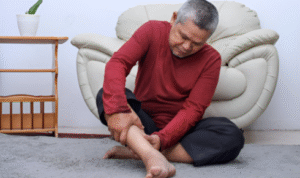
The ankle joint is one of the most significant joints in the human body. It bears our body weight, allows movements such as walking, running, and jumping, and notably plays a crucial role in maintaining balance. When arthritis disturbs the ankle joints, it creates persistent pain, swelling, and difficulty in making simple movements. Have you ever imagined what causes severe arthritis in the ankle joint? Further, let’s have a close look at the ankle joint arthritis, its causes, and contributing factors.
What is arthritis in the ankle?
As we know, arthritis is nothing but an inflammation in the joints. Simply, the ankle bone consists of three bones: the tibia, fibula, and talus. Each ends of these bones are covered with cartilage, which helps them move smoothly against each other. In arthritis, this cartilage breaks down, resulting in bone-on-bone contact, swelling, pain, and reduced mobility, in such cases, you should reach out to the best orthopedic hospital in Coimbatore to get the appropriate treatment.
What are the common types of arthritis that disturb the ankle?
- Osteoarthritis (degenerative joint disease):
- Cause: Over time, the wear and tear will cause this.
- Why does it happen: When aging, the cartilage that cushions the ankle joint will erode slowly.
- Common in: Individuals over the age of 50 are more prone to it, and those who are overweight or have had previous injuries.
- Post-traumatic arthritis:
- Cause: This typically arises from the result of a fracture, dislocation, or severe sprain.
- Why does it happen: Trauma will gradually damage the cartilage directly or the alignment of the joint, resulting in rapid degeneration.
- Common in: Young individuals with a history of ankle injuries.
- Rheumatoid arthritis (RA):
- Cause: This is an autoimmune condition, where the joint lining will be attacked by the immune system.
- Why does it happen: RA results in chronic inflammation, disturbing both sides of the body, including joint inflammation in the ankle.
- Common in: Middle-aged adults, and women are more prone to it.
- Gout:
- Cause: Due to the accumulation of uric acid crystals in the joint.
- Why does it happen: The crystals cause severe pain and inflammation, often beginning in the big toe, but also affect the ankle.
- Common in: Individuals with a high-purine diet, consumption of alcohol, or kidney disease.
- Psoriatic arthritis:
- Cause: Linked to psoriasis, which is an autoimmune skin condition.
- Why does it happen: The immune system attacks healthy joints and tissues.
- Common in: Individuals with psoriasis, even if the effect of the disease is mild.
What actually causes severe ankle arthritis?
Further, let’s see the main contributing causes in more detail:
- Joint injuries:
- Ankle injuries, like fractures, ligament tears, and recurring sprains, can trigger early arthritis.
- Affected cartilage may not heal properly, resulting in joint disability and degeneration.
- Even though the injury heals, misalignment can accelerate wear.
- Genetics:
- A few individuals will inherit genes that make them more susceptible to autoimmune arthritis or poor cartilage repair.
- A family history of RA, osteoarthritis, or gout increases the likelihood of ankle joint involvement.
- Obesity:
- Being overweight adds additional stress to weight-bearing joints, including ankles.
- Even a slight increase in body weight will add more pressure on the ankles, eventually leading to cartilage breakdown.
- Binge use or repetitive stress:
- Engaging in high-impact activities like jumping, running, and specific sports will result in cartilage wear over time.
- Further, if your occupation requires you to stand for a long time or involves heavy lifting can also contribute.
- Inflammatory conditions:
- Persistent swelling due to autoimmune diseases such as RA or psoriatic arthritis will affect the joint tissue.
- These conditions not only disturb the cartilage but also the tendons and ligaments.
- Infections:
- Infections will invade the joint spaces and cause septic arthritis.
- Though rare, if overlooked, it will badly affect your ankle joint in a short time.
- Metabolic disorders:
- Conditions such as gout or hemochromatosis will result in chemical imbalances, disturbing your joint health.
- Uric acid or iron crystals in the joint cause severe swelling and damage.
What are the ankle joint arthritis symptoms?
You need to understand that signs will greatly vary based on the type of arthritis, but commonly include:
- Chronic pain in the ankle, notably with movement
- Inflammation around the joint
- Ankle joint stiffness and swelling
- Tenderness to the touch
- Difficulty walking or bearing weight
- Joint instability
- Clicking and a grinding sound when walking
What are the ways available to treat ankle arthritis?
You need to understand that arthritis cannot be cured, but can only slow down the progression, and can manage the symptoms. The common treatment options include:
- Lifestyle modifications:
- Concentrate on your weight as it can greatly reduce the pressure on your ankle.
- Engage in low-impact activities such as swimming or cycling to enhance joint strength without strain.
- Medications:
Medications will greatly assist in reducing your pain and inflammation. Also, a few medications will treat autoimmune arthritis and also manage gout.
- Physical therapy:
- Concentrates on strengthening the muscles around the joint and improving flexibility.
- Assist in reducing stiffness and improving balance.
- Braces or orthotics:
- Ankle braces assist in offering support and reducing strain.
- Orthotics will enhance alignment and comfort.
- In severe cases, surgery:
- To remove the affected tissue and bone spurs, doctors will recommend arthroscopic surgery.
- In joint fusion, bones will be fused to avoid pain, but it reduces mobility.
- A rheumatoid arthritis specialist in Coimbatore will recommend ankle replacement to reduce pain and regulate your movement.
Final thoughts:
Severe arthritis in the ankle joint is a painful and disabling condition; however, being aware of its causes allows you to take the right preventive measures. Whether it’s from wear and tear, past injuries, autoimmune disease, or lifestyle factors, timely diagnosis and treatment can make a huge difference in maintaining your mobility and quality of life.
















